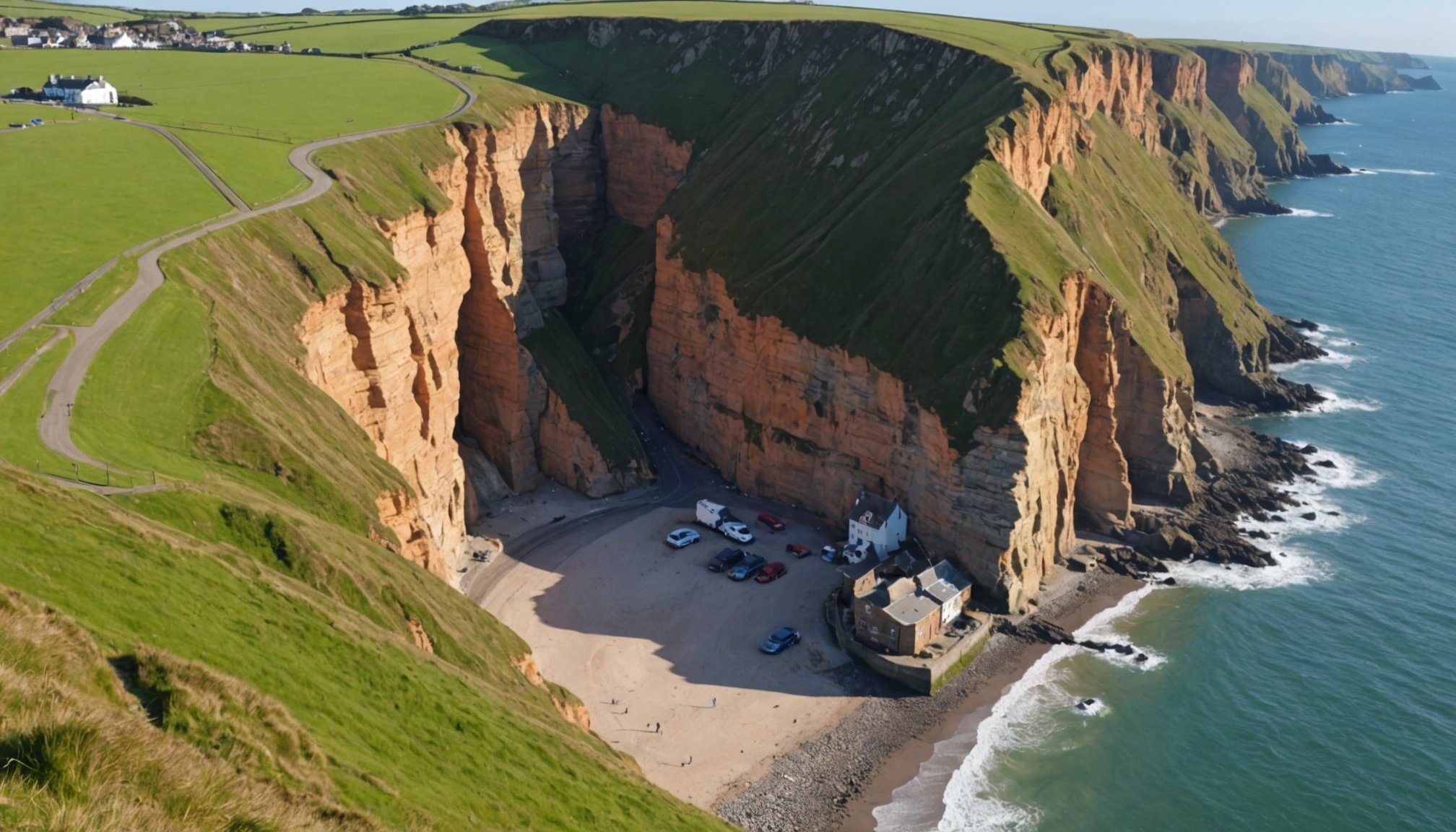Overview of Coastal Cliff Erosion
Coastal cliff erosion is a natural process that significantly impacts many UK coastal communities. This phenomenon involves the wearing away of cliff faces by the constant action of oceanic forces such as waves, tides, and currents. The significance of cliff erosion extends beyond the immediate geographical transformations; it poses a threat to local infrastructures, homes, and the safety and livelihoods of residents.
Several primary causes contribute to coastal cliff erosion. Natural elements, including sea-level rise, intensified storm activities, and wave action, act persistently, wearing down the cliffs. Human activities such as coastal development, sand and gravel extraction, and improper land use can accelerate these effects, increasing the rate of erosion in vulnerable regions.
Also read : Unleash innovative techniques to enhance air quality in crowded living environments
The consequences of beach erosion are manifold and include loss of land, reduced property values, and disruptions to local ecosystems. Communities face economic challenges as vital infrastructures like roads and properties along the coast undergo damage, affecting local tourism and economies dependent on these structures. Ecologically, erosion can lead to habitat loss for native species and disrupt the natural balance of local coastal ecosystems, with potential long-term impacts on biodiversity. Understanding and mitigating these impacts is crucial for sustaining coastal communities across the UK.
Assessment Methods for Coastal Cliffs
Understanding and addressing coastal cliff erosion requires comprehensive assessment methods to accurately monitor and evaluate risk levels.
Also to see : Unpacking the uk building safety act: implications for upcoming development projects
Visual Inspection Techniques
Visual inspections serve as a foundational step in coastal assessment techniques. By regularly examining cliffs, specialists can identify changes in cliff structure and stability, spotting early signs of erosion. These inspections help determine areas most at risk for significant erosion events, enabling quicker, targeted responses to emerging threats.
Technological Tools in Assessment
Modern technology enhances erosion monitoring through advanced methodologies. The use of drones and satellite imagery provides detailed maps, highlighting areas undergoing fast deterioration. This imagery allows for precise monitoring of changes over time, offering a bird’s-eye view that is invaluable for long-term conservation efforts.
Data Collection Methods
Utilising diverse data collection methods is key to comprehensive coastal assessments. Ground surveys, for instance, help gather robust data on cliff composition, height, and changes over time. Consistent collection ensures that risk assessment models are up-to-date, providing a vetted understanding of erosion patterns. Best practices in data handling and analysis then inform effective mitigation strategies, allowing communities and planners to proactively address cliff deterioration before it threatens safety and infrastructure.
Safety Strategies for Coastal Cliff Protection
Ensuring the protection of coastal cliffs involves implementing a range of strategic measures. Soft engineering solutions such as vegetation planting are vital as they leverage natural processes to stabilize eroding cliffs. The roots of planted vegetation can bind soil and rock materials, significantly reducing the risk of erosion over time.
On the other hand, hard engineering options like sea walls and rock armor provide robust, structural defenses against the relentless forces of waves and tides. By absorbing and deflecting wave energy, these structures protect the cliffs from direct impacts, maintaining the integrity of the coastline. However, these solutions can be costly and may require regular maintenance to remain effective.
The importance of continuous safety evaluations cannot be overstated. Regular assessments allow for timely adjustments to protection strategies, minimizing unforeseen risks. This proactive approach is crucial in adapting to changing environmental conditions and ensuring that both soft and hard engineering solutions remain effective.
Integrating these diverse strategies into a coherent plan enables coastal communities to combat the multifaceted challenges posed by coastal cliff erosion, safeguarding infrastructure and habitats alike. Proactive and adaptive management ensures sustained defense for the vulnerable coastal landscapes.
Local Case Studies of Successful Cliff Protection
Exploring case studies of cliff protection illuminates effective strategies and potential pitfalls in coastal management. UK towns have implemented various best practices that serve as models for others facing similar erosion challenges.
Example of a UK Town: Best Practices
In Whitby, robust community engagement has been pivotal. Residents collaborated with local authorities, focusing on vegetation planting to stabilise cliffs. This initiative not only improved cliff stability but also fostered greater environmental responsibility within the community.
Lessons Learned from Failed Initiatives
Conversely, some projects have encountered setbacks. Over-reliance on hard engineering solutions without continuous assessment led to failures. For instance, without proper maintenance, sea walls in Scarborough deteriorated, highlighting the necessity for regular evaluations and adaptability in strategies.
Community Engagement in Case Studies
Communities play a crucial role in protecting their coasts. Through educational workshops, towns like Filey have empowered residents to participate in monitoring efforts. This engagement fosters a collective commitment, ensuring more sustainable interventions.
Such successful interventions underscore the importance of adaptive management and active community participation. By learning from both effective and less successful examples, communities can better equip themselves to safeguard their coastal landscapes.
Government Policies and Regulations
Addressing coastal cliff erosion in the UK necessitates cohesive policies and regulations. The UK Government Initiatives outline critical strategies to manage erosion effectively. These initiatives emphasize the alignment of local strategies with national guidelines to ensure consistent management practices. This alignment is crucial for safeguarding both the environment and infrastructure.
Government policies focus extensively on Environmental Regulations to protect sensitive ecosystems while mitigating erosion impacts. These regulations typically involve restrictions on certain construction activities along vulnerable coastal areas and promote the use of eco-friendly erosion prevention methods.
Funding opportunities form another significant aspect of governmental efforts. The government provides grants and financial assistance to local authorities and communities engaged in coastal management efforts. These funds support projects that seek to preserve natural landscapes and protect against the adverse impacts of erosion, thereby aiding community resilience.
Moreover, comprehensive coastal management policies involve ongoing assessment and adaptation processes. Transparency in such processes enables stakeholders to make informed decisions, integrate scientific findings, and implement effective solutions. By achieving congruence between national standards and local initiatives, the government facilitates a structured approach towards tackling the widespread challenge of coastal cliff erosion.
Community Involvement and Stakeholder Engagement
Engaging local communities and stakeholders is vital in addressing coastal cliff erosion challenges. This involvement not only enhances public awareness but also motivates collective efforts toward sustainable solutions.
Educational Programs and Workshops
Educational programs serve as an effective means of raising public awareness about coastal safety measures. Workshops offer valuable insights into erosion processes, enabling residents to understand the importance of mitigation strategies. By equipping communities with knowledge, these initiatives foster a proactive approach to preservation efforts.
Collaborative Projects with Local Governments
Successful stakeholder collaboration hinges on joint projects with local government bodies. These projects facilitate resource-sharing and enable more comprehensive coastal management solutions. Collaboration ensures that community voices are integrated into decision-making, leading to effective and relevant interventions.
Promoting Volunteer Opportunities
Creating volunteer slots enriches community involvement. Opportunities for residents to engage directly with coastal safety efforts inspire a collective sense of responsibility towards erosion challenges. Whether through beach clean-ups or vegetation planting, volunteering empowers individuals to contribute positively to their environment.
By encouraging active participation, communities leverage diverse perspectives and talents, enhancing the resilience of coastal protection initiatives. The synergy between education, collaboration, and volunteerism is central to achieving long-term sustainability in mitigating the impacts of coastal cliff erosion. This model underscores the pivotal role of communal commitment in safeguarding fragile coastal landscapes.








